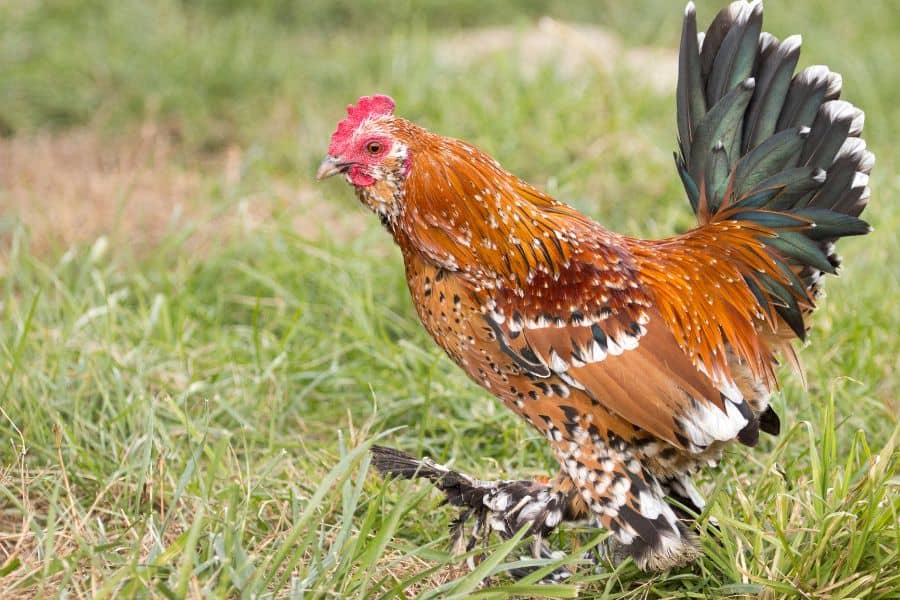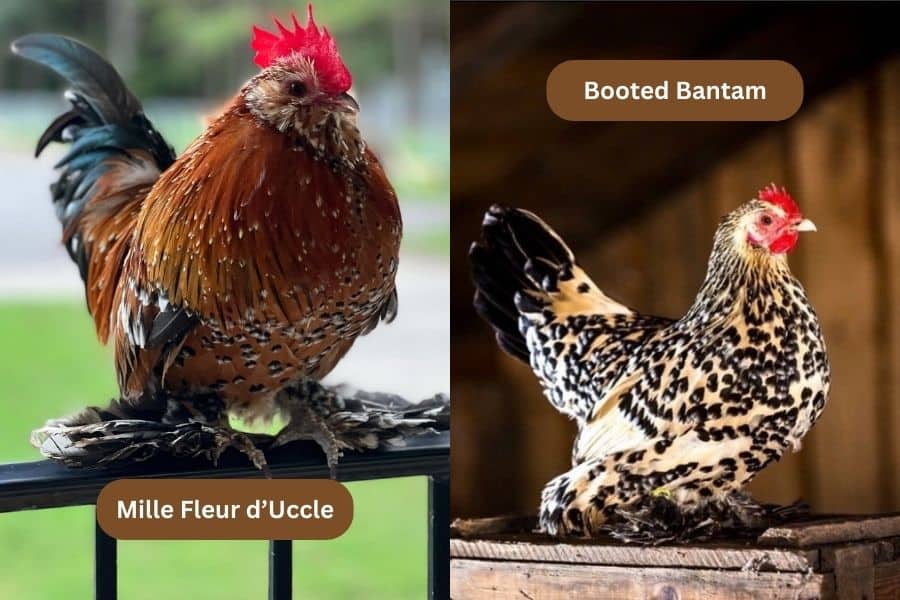Mille Fleur means a thousand flowers in French and if you ever get the privilege of seeing a Mille Fleur d’Uccle, the name will immediately make sense to you. Mille Fleur d’Uccle actually refers to a specific color variety of a breed of chickens.
The story of this bird started in Europe sometime at the end of the 19th century. Soon after, it started to make its way around the world until its spread was interrupted by major events.
The Mille Fleur d’Uccle and other varieties of its breed remain rare today, especially outside their country of origin. However, these birds are prized by their owners not just because of their looks but because of their agreeable temperament.
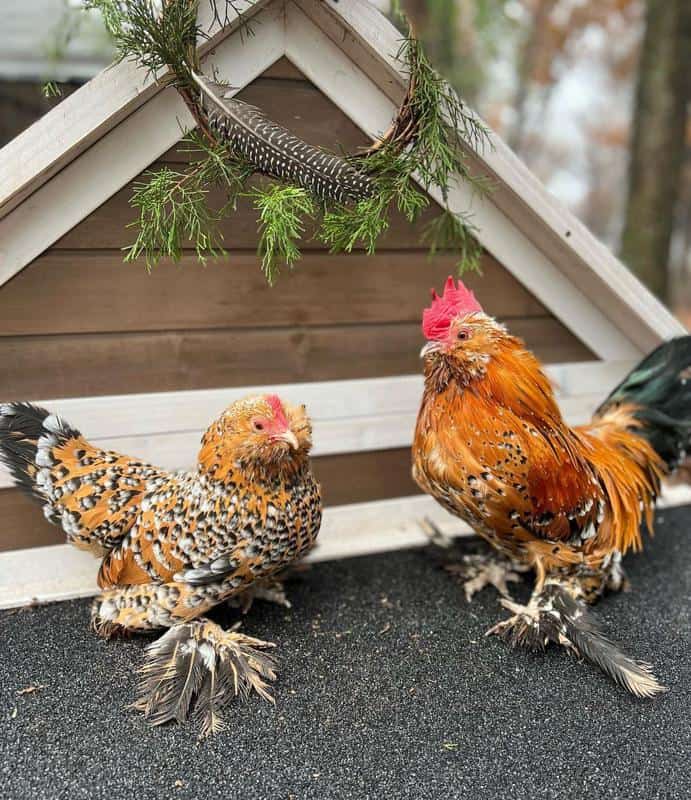
Some of the unique features of these birds mean they need some extra attention around the backyard, but they are fairly easy to rear.
We explore the journey of the Mille Fleur d’Uccle from its development to the present day to uncover why such a special chicken remains so rare.
Mille Fleur d’Uccle Quick Facts
| Names | Mille Fleur d’Uccle |
| Origin | Uccle, Belgium |
| Purpose | Pets and Exhibition |
| Egg Production/Year | 100+ |
| Climate | Cold Hardy, Not Heat Tolerant |
| Plumage Color | Intricate mix of red, orange, white, and black. |
| Weight | Hens: 550g – 790g
Roosters: 740g – 910g |
| Personality | Very Friendly and Cuddly; likes to fly |
| Unique Fact | Is one of the first color variants of the Barbu d’Uccle breed. |
The History of the Mille Fleur d’Uccle
Origin
The Mille Fleur d’Uccle was developed in Belgium in the town of Uccle which shares its name with the breed. The man responsible for the creation of these birds went by the name Michael Van Gelder.
It is believed that the Barbu d’Uccle was developed by breeding the Dutch Booted Bantam chicken, also known as Sabelpoot, with the Barbu d’Anvers breed.
The Mille Fleur color variety was among the first two along with porcelain, but the breed was soon complimented with three more color variants; white, black, and cuckoo.
The Name
Barbu d’Uccle is one of several names that this breed of chicken go by. It is also known as Belgian d’Uccle, and Belgian Bearded d’Uccle.
Across the border, the Dutch call these birds Ukkelse Baardkriel.
The ‘d’ in the name d’Uccle simply means ‘of’ or ‘from’. This translates their name to Barbu of Uccle.
Spread of Mille Fleur d’Uccle Chickens
The Barbu d’Uccle is said to have been first bred sometime between 1890 and 1900, but it wasn’t shown to the public until 1905. However, just four years later, the breed had already become well-established in Belgium.
In 1911, the Barbu d’Uccle made its entry into the UK. That same year, an American poultry artist called Arthur O. Schilling came across a few of these birds, specifically the Mille Fleur d’Uccle.
He brought a few of these birds back home at the end of his trip. Three years later, the Mille Fleur d’Uccle became the first Barbu d’Uccle to be added to the American Poultry Association’s official list of breeds.
Unfortunately, despite their rapid spread early on, the adoption of these chickens was slowed down by both world wars. In Belgium, it is today the 3rd most common true bantam chicken.
The conservation status of this breed is listed as critical today.
The Dazzling Appearance of the Mille Fleur d’Uccle
Plumage
The plumage colors of the Mille Fleur d’Uccle are easier to appreciate visually than they are to explain verbally. Take a look at the hen in the video below.
The roosters’ feathers have a color scheme that is intricate featuring orange feathers with white flecks on the head.
The hackles are black but have golden shafts and the feathers are bordered with orange-red. The black ends of the feathers have white tips.
Surprisingly, due to the number of feathers in the hackles, the main color appears to be orange-red and not black. This intricate mix of red, orange, black, and white is seen in the rest of the birds’ bodies including their wings.
The tail feathers are black but with green iridescence.
The feathering of Barbu d’Uccle doesn’t end at the thighs. These chickens also have feathered legs and feet and these feathers have a similar mishmash of colors but are a little less eye-catching.
For the females, a golden chamois forms the base color of the feathers and each feather has a black end with a white triangular tip. They also have black tail feathers, but these have chamois laces and white ends.
Size
One fact about Mille Fleur d’Uccles you may not have figured out until now is that they are bantam chickens. In fact, Barbu d’Uccles are true bantams.
A true bantam means that the bantam variety of the breed is the only variety available and there is no large fowl option. If you were hoping to get your hands on a regular-sized variety of this bird, you are out of luck.
Different countries have different standards regarding the sizes of these chickens. Here are the recommended weight standards for several countries.
| Country | Rooster Size (g) | Hen Size (g) |
| Netherlands | 700 – 800 | 550 |
| France | 750 | 650 |
| Great Britain | 790 – 910 | 680 – 790 |
| USA | 740 | 620 |
In the USA, there are additional standard weights for cockerels and pullets. Cockerels should weigh about 620 grams while pullets should weigh around 570 grams.
These detailed weight classifications are important because Mille Fluer d’Uccles and other varieties of the Barbu d’Uccle are mainly kept for exhibition.
Also Read: Pretty Chicken Breeds
Mille Fleur d’Uccle vs Booted Bantam
It is easy to confuse the Mille Fleur d’Uccle with the Booted Bantam with a similar plumage color. The similarities between these two are why it is believed the Booted Bantam was one of the breeds used to develop the original Barbu d’Uccle.
The similarities between these birds include:
- Both birds have similar weights.
- Both breeds are true bantams with no regular-sized variants.
- Both chicken breeds are booted, i.e., they have feathers on their shanks and feet.
However, some of the key differences between these birds are:
- Mille Fleur d’Uccles and other Barbu d’Uccles have beards while Booted Bantams don’t.
- The Booted Bantam has larger wattles compared to the Barbu d’Uccle
- Booted Bantams are taller than Barbu d’Uccles.
Mille Fleur d’Uccles Purpose
Ornamental Chickens
Like many bantam chickens, the Mille Fleur d’Uccle makes a great pet. The qualities that make it a popular choice among those looking for feathered pets include:
- Aesthetics: The speckled plumage of these d’Uccles is very eye-catching. As their name suggests, they look like they’ve been sprinkled with a thousand flower petals.
- Size: The small size of these chickens compared to regular-sized chickens means they can be comfortably housed within much smaller spaces.
- Temperament: Mille Fleur d’Uccles are the kind of chicken that will want to cuddle with you as they are quite friendly and don’t mind being handled.
These chickens also make great show birds thanks to their wonderful looks and approachable personalities.
Are Mille Fleur d’Uccles Good for Meat or Eggs?
Mille Fleur d’Uccles are still chicken and this means they can be used in any recipe that calls for chicken.
However, the amount of meat on any bird is quite limited. If you’re making a family dinner, you’ll probably need more than one chicken for that purpose.
Having said that, there are those who swear by the meat of bantams and believe they taste even better than regular chickens. Additionally, having too many cockerels around may not be a good idea so you may still have to explore this option.
A similar issue is seen when it comes to these chickens’ eggs.
One cream-colored egg from these chickens will weigh approximately 30 grams or 1.06 ounces. However, in case you have an excess of Mille Fleur d’Uccle eggs and don’t plan to hatch them all, you’ll be happy to know that they taste just like regular chicken eggs.
Rearing Mille Fleur d’Uccles
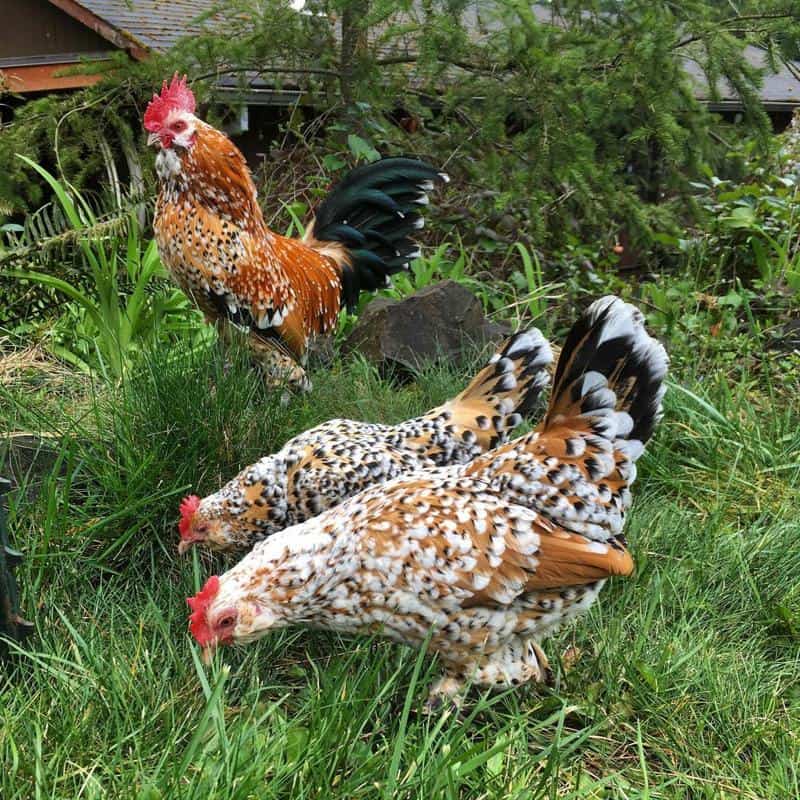
Housing and Environment
When keeping Mille Fleur d’Uccles or any other variety of the Barbu d’Uccle, there are several considerations you must keep in mind about their housing and environment. These include:
- Bantam chickens’ size doesn’t work in their favor when dealing with predators. Even full-grown birds still face greater risks compared to regular-sized chickens and the plumage of Mille Fleur d’Uccles may make them even easier to spot.
- Mille Fleur d’Uccles have a lot of feathering including on their feet and hackles. This means they can cope well with cold weather.
- The feathering mentioned above may be an asset when it’s cold but can be a liability when it’s hot outside. Take suitable precautions to keep your birds cool during hot weather or avoid keeping them in hot climates.
- Mille Fleur d’Uccles are known for their excellent flying ability. To keep them from flying out of their enclosure, you’ll need either a tall fence or a covered run.
- The booted look i.e., the feathered legs and shanks of the Mille Fleur d’Uccle may look great but these feathers are also likely to get matted if your bird is walking around in wet or muddy conditions. Having a covered run can help to prevent this.
Diet
Bantam chickens like Mille Fleur d’Uccles eat the same type of food as regular-sized chickens. There are two notable differences though:
- Quantity
- Consistency
Bantam chickens eat less food compared to regular-sized chickens. This means you won’t have to spend as much if you get a pet bantam.
Because of their small size, bantam chickens may struggle to eat food in the form of regular pellets. A crumble or mash is highly recommended for chickens of this size.
Temperament
There are plenty of good things that can be said about the temperament of Mille Fleur d’Uccle chickens. These chickens are famous for being friendly and taming them is said to be quite easy.
If you have small children and are worried about how well they’ll get along with your chicken, lots of Barbu d’Uccle owners say there is nothing to worry about in this regard.
Although they like to test out their wings, these birds are said to handle confinement quite well and are unlikely to wander too far from home.
The only point of caution is dealing with male Mille Fleur d’Uccles during mating season as they can become a little aggressive. Therefore, having too many males around may not be the best idea.
Lifespan
Bantam chickens like the Mille Fleur d’Uccles are reported to live between 4 and 8 years on average. However, there are many factors to consider.
Under top care in a stress-free environment and with a great diet, these chickens are said to live for over ten years.
Mille Fleur d’Uccle Brooding and Breeding
Mille Fleur d’Uccles and other Barbu d’Uccles are legendary mothers. They are well known for how easily they go broody.
This means that if you wish to get a few more Mille Fleur d’Uccle chickens, you won’t need to look for an incubator.
It also helps that these chickens can lay a fair number of eggs for you.
These chickens can manage over 100 eggs in a year, although some accounts say they can reach 200. Regardless of the exact number, if your plan is to breed more bantam chickens, this is an excellent breed to be working with.
Good Companion Birds to the Mille Fleur d’Uccle
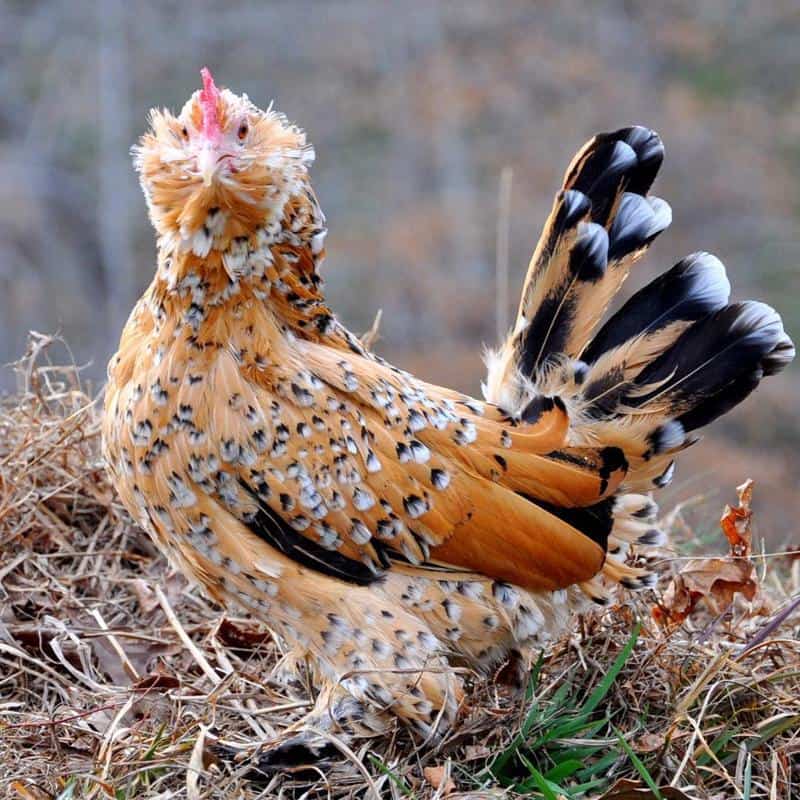
Mille Fleur d’Uccles are social birds which means you may not want to keep only one chicken. Luckily, there are many different birds that can make good companions for them.
For starters, the Mille Fleur d’Uccle is just one variety of the Barbu d’Uccle chicken breed from Belgium. This means that even if you don’t want another Mille Fleur d’Uccle, there are plenty of similar chickens to choose from within the same breed.
In the US, there are 7 varieties of the Barbu d’Uccle that are recognized by the American Poultry Association. However, in Belgium, there are a total of 28 listed color variations of this chicken breed.
This means there’s a huge variety of chickens you can choose from without going to a different breed.
If you already have regular-sized chickens and would like to introduce a Mille Fleur d’Uccle, avoid putting it with chickens that tend towards aggression. The d’Uccle’s size will quickly make her target.
Even when paired with friendlier regular-sized chickens, it’s still a good idea to keep their feed and water separate. You should also consider a separate coop for the Mille Fleur d’Uccle and other bantams.
Also Read:
A Great Companion with Some Needs
Mille Fleur d’Uccles are not one of the most common chickens around. Because of their size, they are mostly popular with individuals who are looking for pet chickens or those interested in taking them to shows.
These birds are one plumage variety of the Barbu d’Uccle chicken breed from Belgium.
The breed has been around since the end of the 19th century but didn’t get to establish itself around the world. As a result, this breed is relatively rare.
Mille Fleur d’Uccles are arguably the most eye-catching members of this breed due to their unique plumage. The housing needs of these chickens are modest but special care should be taken to keep their feathered legs clean and dry.
The females are well-known to be great mothers, and the temperament of these chickens makes them popular pets. If you were looking for an interesting, feathered companion, the Mille Fleur d’Uccles will be a joy to have around.
